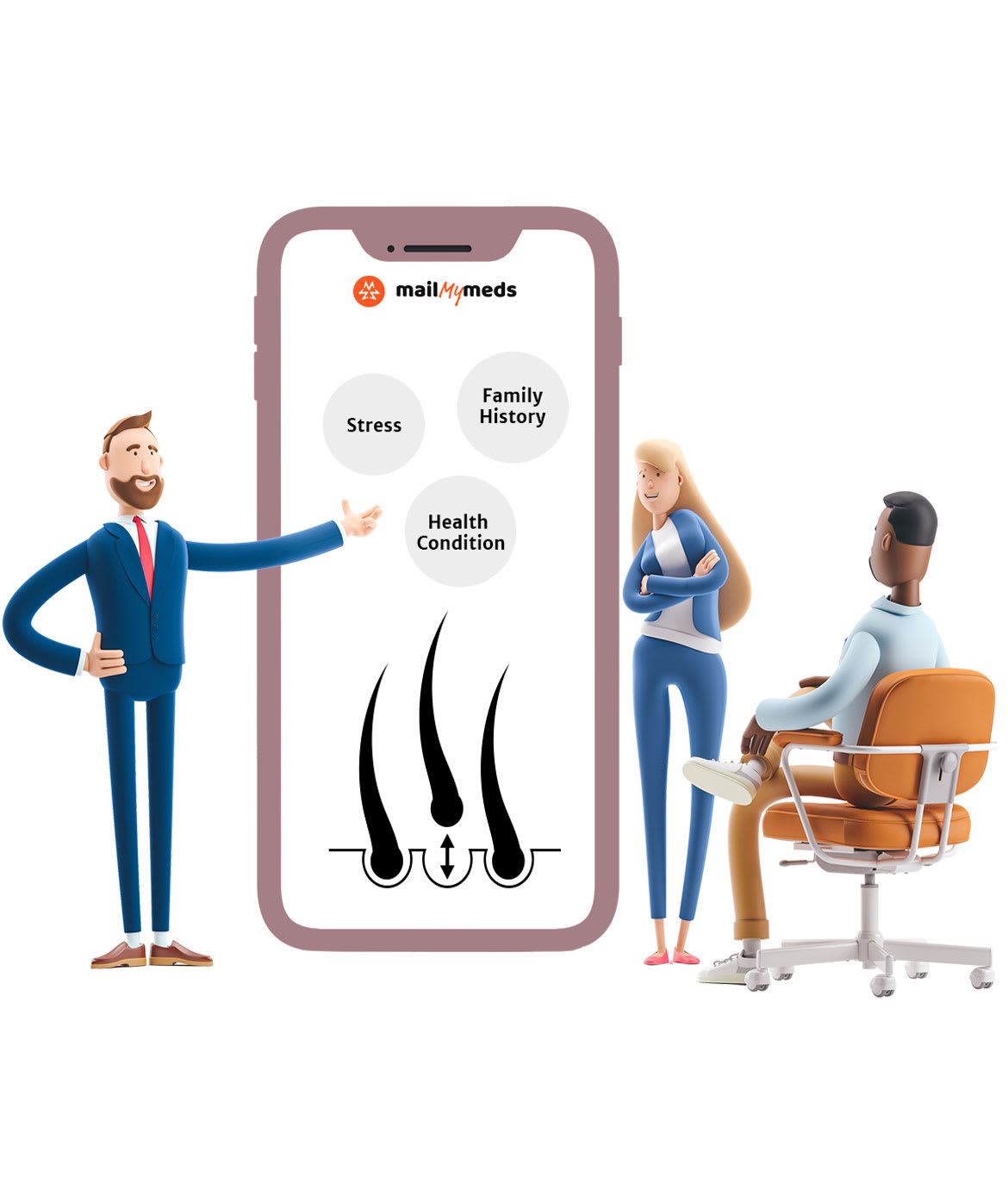Effective Hair Loss Treatments Prescribed Online
Whether you struggle with a receding hairline, balding, thinning hair, or alopecia, we have what you need. Complete a quick online consultation and begin your hair loss treatment today.
Regrow Your ConfidencePrescribed Online, Fast Delivery
FDA approved

Hair Loss
Hair loss can begin gradually or abruptly, both of which can be a stressful experience. It may be time to seek hair loss treatment if your hair is thinning, your hairline is receeding, or bald patches are affecting your scalp. With the right treatment, hair regrowth is often possible. The right hair loss treatment for you will depend on the type of your hair loss.
Some hair loss treatments come in a tablet and are taken orally, like finasteride. Other forms of medication include topical solutions, shampoos, and foams. Topical hair loss treatments often contain the active ingredient minoxidil, which is the generic version of Rogaine. Whichever medication you are prescribed, always administer it exactly as your doctor directs for best results. It is also important to complete your treatment fully because stopping too early can cause your hair to fall out again.
Which treatment is best for me?
Finasteride is a great option to treat hair loss in men. It conveniently comes in an oral tablet and is available in brand-name and generic versions. Finasteride prevents the conversion of testosterone to dihydrotestosterone (DHT) by inhibiting certain enzymes in the body. Since DHT shrinks the hair follicles, finasteride effectively promotes hair growth by lowering DHT levels. {{1}}
Minoxidil is another popular hair loss medication. It is applied directly to the affected scalp areas and works by shortening the resting phase and lengthening the growing phase of the hair growth cycle. Minoxidil also improves blood circulation to the scalp, further stimulating hair growth. {{2}} Minoxidil is available in a topical solution or foam, offering different penetration levels. Your physician will determine which hair loss prevention medicine is best based on the cause and severity of your hair loss, age, and sex.
References:
{{1}} https://pubmed.ncbi.nlm.nih.gov/9951956/
{{2}} https://pubmed.ncbi.nlm.nih.gov/22409453/
Most hair loss medications work by lengthening the active growing phase of the hair growth cycle. As a result, it takes time for the hair follicles to produce new hairs. Generally, it takes around four to six months before there are noticeable improvements in hair growth and density. After one year of treatment, you can expect the full benefits of the medication, at which point you and your doctor may gauge the results and decide on the next steps of your hair loss prevention journey.
Those who have a hair loss condition may require treatment indefinitely. Sometimes, the root cause of hair loss can be identified and resolved, leading to full and natural hair growth once again. For example, removing certain stressors from your life may cure your alopecia if stress is what’s causing your hair loss.
But age and hereditary factors may be outside your control. As such, many patients continue taking hair loss medications past the one-year mark. The good news is that long-term use of hair loss treatments is effective. One study conducted in Korea found that finasteride produces sustainable results for at least five years. {{1}} The final results from hair loss medication usually occur after one year of use, and a maintenance dose may be prescribed to prevent returning hair loss.
References:
{{1}} https://pubmed.ncbi.nlm.nih.gov/9951956/
Many types of hair loss are caused by things you do. Your hair loss can be completely reversible if you are damaging your hair by perming, coloring, or relaxing it. Sometimes, hair loss may be caused by a mental disorder. In the case of compulsive hair pulling, the hair follicles that have been pulled out may have difficulty regrowing hair, but there are steps you can take to prevent further hair loss.
Many other causes of hair loss can be treated, leading to hair regrowth. Scalp psoriasis, for example, can be cleared up with the help of a dermatologist. Afterward, the hair that was damaged by the psoriasis may regrow with time. Evidently, whether hair loss can be cured depends on the type of condition you have. The first step to treating hair loss is getting a proper diagnosis and starting on your prescribed treatment plan.
Types of Hair Loss Conditions
Medically called male androgenic alopecia (MAA), male pattern hair loss is caused by inherited genes that cause your hair follicles to shrink and stop growing hair. {{1}} Hereditary hair loss is a common condition that affects men and women alike, ans is often characterized by a receding hairline in men and a widening part in women.
Another possible cause of hair loss is an autoimmune disorder called alopecia areata. With this condition, the person’s own immune system attacks the hair follicles. {{2}} Alopecia areata may cause hair loss anywhere on the body and not just your scalp. Some patients with this condition experience hair loss on their face (eyelashes and eyebrows) or inside the ears and nose.
Certain medical treatments commonly lead to hair loss as well. For example, cancer treatment, including chemotherapy and radiation treatment, may cause partial to complete hair loss. After the treatment is complete, the hair usually grows back within a few months. Some hair loss treatments can help the hair grow back faster.
References:
{{1}} https://www.ncbi.nlm.nih.gov/books/NBK278957/
{{2}} https://www.ncbi.nlm.nih.gov/pmc/articles/PMC5939003/
Stopping hair loss may include lifestyle changes such taking on a new diet or incorporating stress-relieving exercises. If your condition requires prescription medication, stopping hair loss will involve the timely and proper use of your meds.
Treating the underlying cause is just as important as taking the prescribed medications. To stop the loss, your doctor may first examine your health to determine why your hair is falling out. Then, you may be prescribed the appropriate treatment for the condition. To start your hair regrowth journey complete our quick online consultation and receive your treatment in the mail today.

By the age of thirty-five two-thirds of American men will experience some degree of appreciable hair loss, and by the age of fifty approximately 85% of men have significantly thinning hair " (Source).
Find a Treatment That Suits You
Topical or Oral Options For Every Routine Choose your treatment plan and click "Start Treatment Today" to begin achieving your hair goals.
Minoxidil + Finasteride

6% + 0.28%
Powerful and effective. All the benefits of minoxidil and finasteride in a convenient dropper bottle. A topical solution to stimulate regrowth and revitalize your hair.
5-in-1 Hair Loss Solution

5.6% + 0.28% + 0.015% + 1.7% + 0.2%
Like topical minoxidil + finasteride but fortified. With ketoconazole, tretinoin, and biotin, this is the dream team. Ingredients that work together to ensure absorption and maximize effectiveness.
Finasteride

1mg
Tackle hair loss systemically with this hassle-free pill. The go-to treatment for male pattern baldness. Finasteride is the heavy-hitter in hair loss treatment.
Minoxidil

2.5mg
Revitalize your scalp with oral minoxidil tablets. These daily pills extend the hair growth period and provide a strong foundation for a fuller, healthier head of hair. See results in mere months. Suitable for men and women.
Read More
What Causes Hair Loss?
Alopecia (hair loss) can be caused by stress, health conditions, and family history. Determining the root cause can help get you on the most suitable treatment plan to prevent hair loss.
What's Causing my Hair Loss?
Treatment Options
Understanding Hair Loss Treatment Options
Hair loss can be frustrating. Luckily, several treatment options are available. Topical medications like minoxidil or finasteride are a common first line of treatment, but there are additional options that can help complete your treatment plan.
Learn More About Treatment Options
Search Medication Prices
Find out how much you can save on your prescription drugs with mailMymeds.


